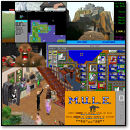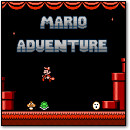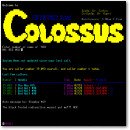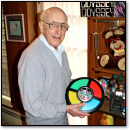Archive for September, 2010
[ Fuzzy Memory ] Isometric Civilization with Mechs?
Friday, September 24th, 2010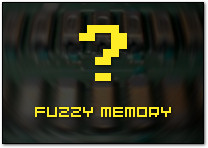 Every once and a while, I receive emails from people looking for a certain game, electronic toy, or computer from their distant past. I then pass it on to intrepid VC&G readers to crack the case.
Every once and a while, I receive emails from people looking for a certain game, electronic toy, or computer from their distant past. I then pass it on to intrepid VC&G readers to crack the case.
The Clues
Brenton writes:
I’ve been trying to find an old game I remember playing on an old Windows machine when I was a child. I’m 23 right now, and I would have been something between 8 and 12 when I was playing this [about 1995 – 1999, Ed.], but I don’t want to set that in stone.
The game was a fun little strategy game viewed from an isometric perspective. You controlled an island nation drawn with sprites, and you would spend the game building power plants (maybe?), and missile silos, eventually building these launch pads for walking robots. You would send these sprite-robots over and let them rampage around the opponent’s island, hopefully killing him. I remember spending HOURS playing this game, but though I’ve been searching for it for a few months, I haven’t been able to find a single thing out about it. I am guessing that it came on some kind of compilation CD, since it doesn’t appear to be a launch title with any OS.
Any help would be VERY appreciated!
Thanks in advance,
Brenton
The Search Begins
It’s up to you to find the object of Brenton’s fuzzy memory. Post any thoughts or suggestions in the comments section below. Brenton will be monitoring the comments, so if you need to clarify something with him, ask away. Good luck!
—
Have a memory of a computer, video game, computer software, or electronic toy you need help identifying? Send me an email describing your memories in detail. Hopefully, the collective genius of the VC&G readership can help solve your mystery.
[ Retro Scan of the Week ] Procomm Plus for Windows
Monday, September 20th, 2010 “PROCOMM PLUS: Totally Connected”
“PROCOMM PLUS: Totally Connected”
I used Procomm Plus for DOS during my early years of BBSing, although I called it “PC Plus” because of its shortened executable file name, “PCPLUS.EXE”. I never did migrate to Procomm Plus for Windows, although I remember salivating over it in a software store back when anything and everything modem-related exciting me.
“Terminal” for Windows 3.1 left a bad taste in my mouth, so I didn’t use a GUI-based terminal emulator steadily until the Windows 98 era. After using PC Plus for a few years, I switched to Telix (essentially a PC Plus clone), and one my friends swore by Telemate, which touted some advanced features for a DOS terminal program.
Ah; those were the days.
I’d be interested to hear about your terminal software experiences on all platforms. Hit me up in the comments below.
(P.S. If you’re interested in BBSing again, telnet to my BBS at cavebbs.homeip.net.)
Discussion Topic of the Week: What’s your favorite terminal emulation software of all time?
[ Retro Scan of the Week ] Radio Shack Slot Machine
Monday, September 13th, 2010 “Play slots anywhere you go without the expense!”
“Play slots anywhere you go without the expense!”
I believe I bought this Radio Shack LCD Mini Slot Machine unit at a hamfest back in the 1990s. The game broke not too long afterward, but I apparently kept the box and the manual.
Fast forward 15 years later. I recently discovered the box in a pile of my old stuff at my parents’ house. After flattening the box, I scanned the whole thing so you can create your own tiny three dimensional reproductions of it at home (if you’re into that Radio Shack diehard papercraft thing). Heck, fill a whole room with them and dive in!
Discussion Topic of the Week: Did you (or do you) ever own any Radio Shack electronic games? Which ones?
Mac OS X Turns 10
Monday, September 13th, 201010 years ago today, Apple released the Mac OS X Public Beta. It was the general public’s first chance to experience the new OS and the commercial debut of the software (a previous release, confusingly named “OS X Server,” was based on a pre-OS X prototype called Rhapsody).
The Public Beta sold for $29.95, and Apple offered that amount off the purchase of OS X 10.0 for those who bought the Beta.
I’ve always been a fan of OS X, and this anniversary got me wondering how development on this very innovative OS started. After some digging, I wrote a brief history on the origins of OS X for Macworld. I was fortunate to have the help of Avie Tevanian, former VP of Software Engineering at Apple (1997-2006), as a reference to help me get some points straight.
While I was at it, I also wrote a shorter piece about some of the differences between the Public Beta and Snow Leopard (the most recent version of OS X).
What are your thoughts on OS X? Do you use it? Did you use it? Let us know in the comments.
Super Mario Memories — Mine and Yours
Monday, September 13th, 2010
Super Mario Bros. turned 25 years old today.
I first played this NES masterpiece when I was about six years old — around late 1986 or early 1987. I remember visiting the house of my brother’s friend, venturing upstairs and seeing a futuristic grey box attached to his TV set. There, on the screen, unfolded an astoundingly magical, enchanting, mysterious, and captivating world of mushrooms, flying turtles, and flowers that imbued your character with the power of fire.
What enchanted me the most (aside from the fantastically whimsical setting) was the fact that Nintendo had packed the game with secrets like invisible blocks, hidden extra men, and — my god — warp zones. Us kids had even heard rumors of the Minus World, which prompted joyful quests to uncover every mystery of the game.
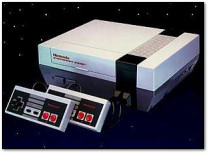 Before the NES, video games to me meant Atari 800 and 2600, which I had seen my older brother playing throughout my early youth. I loved them, sure, but Super Mario Bros. simply blew my mind. It was nothing, and I mean nothing, like that which had come before. SMB elevated video games to an entirely new plane of existence in terms of its worldview and philosophy of play. For the first time, I truly felt like I was visiting another land — and living out an alternate life — in a video game.
Before the NES, video games to me meant Atari 800 and 2600, which I had seen my older brother playing throughout my early youth. I loved them, sure, but Super Mario Bros. simply blew my mind. It was nothing, and I mean nothing, like that which had come before. SMB elevated video games to an entirely new plane of existence in terms of its worldview and philosophy of play. For the first time, I truly felt like I was visiting another land — and living out an alternate life — in a video game.
For folks born after 1990 or so, what I’ve written above may seem like a load of hyper-inflated flowery language. But it’s very hard to exaggerate the impact that Super Mario Bros. — a game that sold 40 million copies — had on the video game industry, on the cultural world at large, and on the lives of an entire generation. It was that important.
You Tell Me
So now I turn to you. What are your memories of Super Mario Bros.? When did you first play the game and how did you feel about it?
Super Mario Oddities (Super Mario Bros. 25th Anniversary)
Monday, September 13th, 201025 years ago today, Nintendo released Super Mario Bros. for the Famicom in Japan. In honor of this anniversary, I decided to dive into the depths of Super Mario lore and legend.
I surfaced clutching 13 examples of Mario-related weirdness, which I conveniently packaged in a slideshow format for Technologizer. The result is Super Mario Oddities, a gallery in the same vein as my Game Boy Oddities piece from last year. I hope you enjoy it.
20 Years of Internet Search
Friday, September 10th, 2010The Internet’s first search engine, Archie, launched 20 years ago today. To celebrate this occasion, I decided to look back at the early days of many search engines (mostly web) of the past 20 years. The resulting slideshow is up on PC World.com for all to see. I hope you enjoy it.
[ Retro Scan of the Week ] Apple IIc Flat Panel Display
Monday, September 6th, 2010 Apple IIc and the Apple Flat Panel Display
Apple IIc and the Apple Flat Panel Display
I’ve always loved this cover shot. It bursts with vivid, colorful photography of a particularly beautiful Apple IIc.
“Particularly,” I said, because this Apple IIc is not in its usual configuration. It sports a rare and wondrous peripheral known as the Apple Flat Panel Display, an LCD monitor which initially sold for $595 (that’s about $1,205 in 2010 dollars) in 1985.
Despite being Apple’s first LCD display, the device sold poorly. Here’s why: For one thing, it was way too expensive for what you got. And what you got wasn’t that great. Sure, it displayed 80 columns by 24 lines and even high resolution graphics, but in a bizarrely squat screen ratio. In a 1985 review of the monitor, Infoworld wrote, “…characters displayed on the Flat Panel Display have the same oddly stretched appearance of writing on a fat man’s T-shirt.”
The same review notes how difficult it was to read the non-backlit display under any lighting conditions — bright light, dim light, direct light, etc. The combination of intense glare and low contrast made the monitor uncomfortable to use. Mix those elements together, and you have yourself a recipe for a genuine ahead-of-its-time Apple flop: innovative, but not quite ready for prime time yet. Sound familiar?
Still, I’d love to get my hands on an Apple Flat Panel Display and report my experiences directly to you. If anyone out there has one that they’d like to get rid of, please let me know.
Discussion Topic of the Week: When did you first use a computer with an LCD screen? When (if ever) did you switch to using LCD screens on your desktop PCs?
Great Images in 1-Bit Color: Mona Lisa
Thursday, September 2nd, 2010

An image like this should be familiar to early Macintosh users, since the first Macs only supported 1-bit color. That is, two colors total: each pixel could be black or white — on or off — and nothing in between. The image above uses only black and white and a dithering effect to trick your brain into perceiving shades of grey. Somehow, it makes me feel warm and fuzzy inside.
Update: Hover over the image to see 1-bit Mona Lisa rendered with Floyd-Steinberg error diffusion, which is another algorithm for converting color images to black and white.






